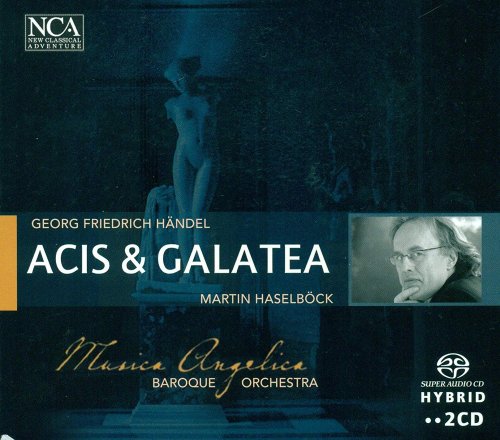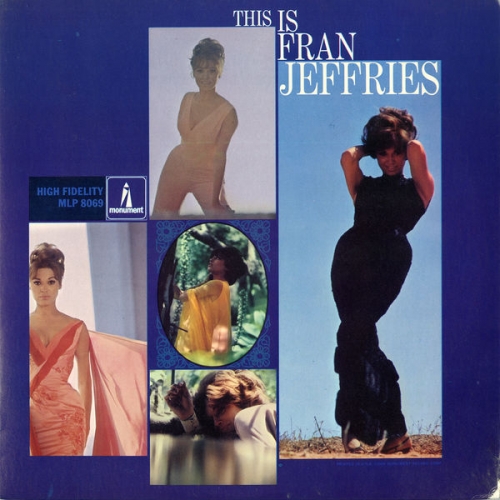Martin Haselböck & Musica Angelica Baroque Orchestra - Handel: Acis & Galatea (2009)

Artist: Martin Haselböck & Musica Angelica Baroque Orchestra
Title: Handel: Acis & Galatea
Year Of Release: 2009
Label: New Classical Adventure
Genre: Classical
Quality: FLAC (image + .cue, log, artwork)
Total Time: 01:29:57
Total Size: 416 MB
WebSite: Album Preview
Tracklist:Title: Handel: Acis & Galatea
Year Of Release: 2009
Label: New Classical Adventure
Genre: Classical
Quality: FLAC (image + .cue, log, artwork)
Total Time: 01:29:57
Total Size: 416 MB
WebSite: Album Preview
CD 1
1. Sinfonia
2. Oh, the Pleasure of the Plains!
3. Ye Verdant Plains and Woody Mountains
4. Air Hush, Ye Pretty Warbling Quire!
5. Where Shall I Seek the Charming Fair?
6. Stay, Shepherd, Stay! - Shepherd, What Art Thou Pursuing?
7. Lo, Here My Love, Turn, Galatea - Love in Her Eyes Sits Playing
8. Oh! Didst Thou Know the Pains of Absent Love - As When the Dove Laments Her Love
9. Happy We!
CD 2
1. Wretched Lovers!
2. I Rage - I Melt - I Burn
3. O Ruddier Than the Cherry
4. Whither, Fairest, Art Thou Running - Cease to Beauty to Be Suing
5. Would You Gain the Tender Creature
6. His Hideous Love Provokes My Rage - Love Sounds Th'alarm
7. Consider, Fond Shepherd
8. Cease, Oh Cease, Thou Gentle Youth - The Flocks Shall Leave the Mountains
9. Help, Galatea!
10. Mourn, All Ye Muses!
11. Must I My Acis Still Bemoan
12. 'Tis Done! - Heart, the Seat of Soft Delight
13. Galatea, Dry Thy Tears
The delectable masque Acis and Galatea , which Handel wrote in 1718 while composer-in-residence to the Earl of Carnarvon (usually referred to in Handel literature by his later title, Duke of Chandos), has a substantial recorded history. In addition to this recording, there are 11 others listed at ArkivMusic, most of which have something to offer, and several have their champions among Fanfare ’s critics.
Handel performed Acis and Galatea at Cannons with a small force: one soprano, three tenors, and a bass, who also sang the choruses (one tenor had no solo music). The orchestra probably had no more than seven players: two violins, two oboes (doubling recorders), two cellos, and harpsichord. Acis and Galatea was revived often during Handel’s lifetime, frequently in a combined English-Italian version meant to fend off competition but damaging to the integrity of the work. Revivals in English cut some numbers while dividing the work into two acts and adding the chorus “Happy We” at the end of act I.
Most recordings are based on the Cannons version, generally employing only five vocalists but usually beefing up the orchestral forces. Haselböck uses six violins, two violas, two cellos, bass violin, two oboes, recorder, and harpsichord. The notes give no source for the music played by the violas; presumably the bass violin doubles the continuo harpsichord line. He leads a lively, reasonably paced performance. The orchestra plays expertly, showing why it is considered “Southern California’s premier Baroque orchestra.”
The soloists are generally very good, although they do not quite equal the best of the competition. Linda Perillo sings with a minimum of vibrato, but there is enough for us to tell that the sound is coming from a human being rather than a computer. She has no problems with her florid music and has sufficient personality to create a believable character. Her Acis, Mark Bleeke, has a strong, somewhat unusual voice. There is sometimes a lachrymose quality to it, as if he were about to burst into sobs. He also is adept at the florid music Handel gives him, but I found him less convincing as a lover; he lacks elegance and is more convincing in his defiance of Polyphemus. William Hite also has a rather heroic voice, more so than the type of tenor usually assigned Damon’s arias. This is not a criticism, however; he sings well. The third tenor, Gerald Thomas Gray, is given the name Coridon, a name that does not appear before Handel’s 1731 revival. Coridon was given Damon’s aria “Would You Gain the Tender Creature” to sing at this and subsequent revivals. Here, Coridon is merely a member of the chorus. Florian Boesch has a heavy-sounding voice, which lends credence to his portrayal of Polyphemus. But his voice is supple, and he sings his florid music without aspirating.
Da capo ornaments are tasteful and kept to a minimum. Haselböck injects a bit of humor in Galatea’s “Hush, Ye Pretty Warbling Choir” by giving the cadenza to the recorder, with Galatea whispering “hush.” The original version of the chorus “Galatea, Dry Thy Tears” was 19 bars longer than that in any of the printed scores. Haselböck performs what I presume is the original version, the first recording I have heard that includes it.
While I enjoyed this recording very much, it does not quite equal my favorite. Robert King on Hyperion is the best available, with a nod to John Eliot Gardiner’s Archiv recording as a close second. Anyone who purchases the Haselböck discs will, however, have one of the best recordings of this essential work. -- FANFARE: Ron Salemi
Handel performed Acis and Galatea at Cannons with a small force: one soprano, three tenors, and a bass, who also sang the choruses (one tenor had no solo music). The orchestra probably had no more than seven players: two violins, two oboes (doubling recorders), two cellos, and harpsichord. Acis and Galatea was revived often during Handel’s lifetime, frequently in a combined English-Italian version meant to fend off competition but damaging to the integrity of the work. Revivals in English cut some numbers while dividing the work into two acts and adding the chorus “Happy We” at the end of act I.
Most recordings are based on the Cannons version, generally employing only five vocalists but usually beefing up the orchestral forces. Haselböck uses six violins, two violas, two cellos, bass violin, two oboes, recorder, and harpsichord. The notes give no source for the music played by the violas; presumably the bass violin doubles the continuo harpsichord line. He leads a lively, reasonably paced performance. The orchestra plays expertly, showing why it is considered “Southern California’s premier Baroque orchestra.”
The soloists are generally very good, although they do not quite equal the best of the competition. Linda Perillo sings with a minimum of vibrato, but there is enough for us to tell that the sound is coming from a human being rather than a computer. She has no problems with her florid music and has sufficient personality to create a believable character. Her Acis, Mark Bleeke, has a strong, somewhat unusual voice. There is sometimes a lachrymose quality to it, as if he were about to burst into sobs. He also is adept at the florid music Handel gives him, but I found him less convincing as a lover; he lacks elegance and is more convincing in his defiance of Polyphemus. William Hite also has a rather heroic voice, more so than the type of tenor usually assigned Damon’s arias. This is not a criticism, however; he sings well. The third tenor, Gerald Thomas Gray, is given the name Coridon, a name that does not appear before Handel’s 1731 revival. Coridon was given Damon’s aria “Would You Gain the Tender Creature” to sing at this and subsequent revivals. Here, Coridon is merely a member of the chorus. Florian Boesch has a heavy-sounding voice, which lends credence to his portrayal of Polyphemus. But his voice is supple, and he sings his florid music without aspirating.
Da capo ornaments are tasteful and kept to a minimum. Haselböck injects a bit of humor in Galatea’s “Hush, Ye Pretty Warbling Choir” by giving the cadenza to the recorder, with Galatea whispering “hush.” The original version of the chorus “Galatea, Dry Thy Tears” was 19 bars longer than that in any of the printed scores. Haselböck performs what I presume is the original version, the first recording I have heard that includes it.
While I enjoyed this recording very much, it does not quite equal my favorite. Robert King on Hyperion is the best available, with a nod to John Eliot Gardiner’s Archiv recording as a close second. Anyone who purchases the Haselböck discs will, however, have one of the best recordings of this essential work. -- FANFARE: Ron Salemi







![Lionel Hampton - Jam Session in Paris (Remastered) (2022) [Hi-Res] Lionel Hampton - Jam Session in Paris (Remastered) (2022) [Hi-Res]](https://www.dibpic.com/uploads/posts/2025-12/1766737729_lhjp500.jpg)
